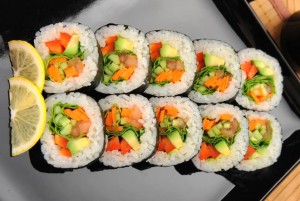
Image Credit: http://fruitguys.com/almanac/2011/05/05/roll-your-own-how-to-make-vegetarian-sushi
Although sushi is simple and delicious, it sometimes requires ingredients that can be a little on the expensive side. Luckily, there are alternative, less expensive ingredients that can be used to make sushi that is equally delicious!
Of course, buying in bulk is also a great way to save money on sushi ingredients. Japanese sushi rice is generally sold in bulk quantities, so this can help you save as well. Once you make the rice, you can even freeze it in a plastic bag to save to use another time; it will stay fresh in the freezer. This will also help you save time later on if you are in a rush to cook! Sushi rice is usually inexpensive when bought in bulk; however, quinoa can also be used as a substitute ingredient if you can find some that’s less expensive at a local grocery! It is a little harder to roll because it does not have quite the same sticky texture as sushi rice, but with a little extra care, it certainly can be done!
Somewhat like the Japanese immigrants did when they substituted avocado for salmon, we’ll be substituting sweet potato for any seafood. This ingredient has a somewhat similar texture, but sweet potatoes cost a lot less than fish, which certainly helps on a student budget. In addition to sweet potato, this recipe will use shiitake mushrooms. Most of the time, when this sushi is made it is seasoned with scallions; however, finely cut, cooked onions can be used as well. The sweet potato should also be cooked, then cut into thin strips.
Take a sheet of seaweed, then fold and tear off a two-inch strip. Spread a layer of rice (or quinoa) over the large sheet of seaweed, but remember to leave a border on the top and bottom edges. Fold the bottom edge of seaweed up over the rice layer, and lay the seaweed strip down. Line the sweet potato, shiitake mushrooms, and sliced onions on the seaweed, and bring the whole layer down to the edge of the bamboo mat. Roll the sushi together, cut into eighths, and enjoy!
This is the ninth chapter from an e-book by one of the Campus Clipper’s former publishing interns, who wrote about how to make sushi. Follow our blog for more chapters from this e-book. We have the most talented interns ever and we’re so proud of them! For over 20 years, the Campus Clipper has been offering awesome student discounts in NYC, from the East Side to Greenwich Village. Along with inspiration, the company offers students a special coupon booklet and the Official Student Guide, which encourage them to discover new places in the city and save money on food, clothing and services.
At the Campus Clipper, not only do we help our interns learn new skills, make money, and create wonderful e-books, we give them a platform to teach others. Check our website for more student savings and watch our YouTube video showing off some of New York City’s finest students during the Welcome Week of 2015.
Become a fan on Facebook and follow us on Twitter and Instagram











